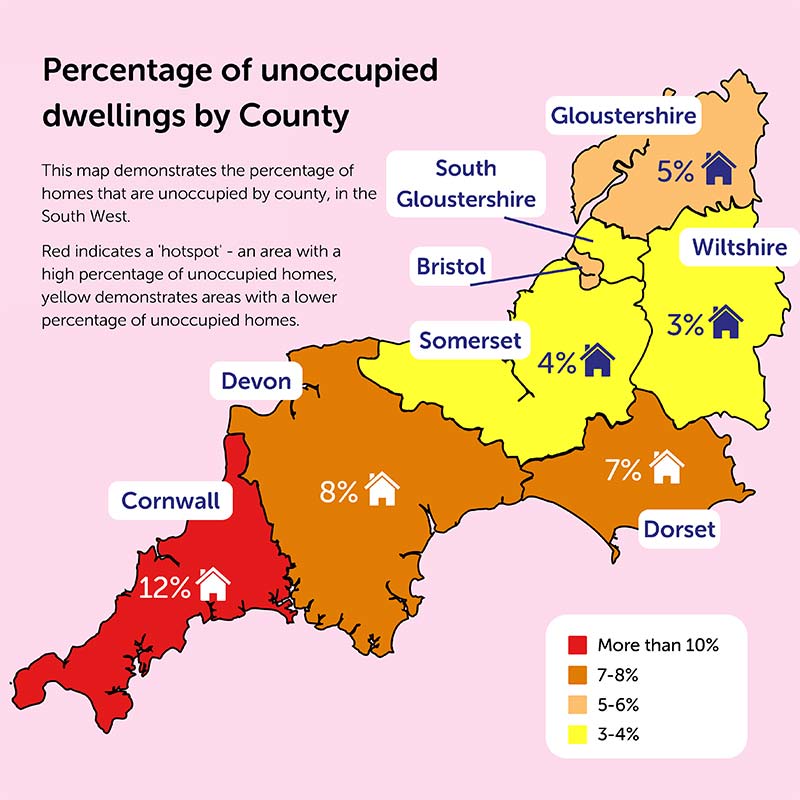While the UK is suffering a high level of homelessness, Dorset has a high number of unoccupied homes in the South West.
The Frettens team has closely analysed the data from the 2021 Census and ONS figures on UK dwellings to determine the percentage of unoccupied dwellings in Dorset, and how it compares to the rest of the South West.
In addition to looking at the South West data, we’ve taken an overview of the remainder of England so we can compare both and understand the reasons for Dorset being an area with a high percentage of uninhabited homes.
Unoccupied Home Percentages for the South West
The highest percentage of unoccupied dwellings for Counties and Unitary Authorities in the South West are:
- Cornwall – 12%
- Devon – 8%
- Dorset – 7%
- Torbay – 6%
- Bournemouth, Christchurch and Poole – 6%

While the Dorset area does not rank in 1st place for the highest percentage of unoccupied dwellings, it does still rank high for a smaller County at 3rd place. Dorset has a total of 182,079 dwellings, but only 169,300 of these are occupied by at least one regular inhabitant, leaving a total of 12,779 properties regularly uninhabited.
The lowest percentage of unoccupied dwellings for Counties and Unitary Authorities in the South West are:
- Wiltshire – 3%
- South Gloucestershire – 3%
- Swindon – 4%
- North Somerset – 4%
- Somerset – 4%
At the lower end of the scale is the County of Wiltshire which, in total, has 222,097 total dwellings, 215,100 of which have a minimum of one usual resident. This leaves 6,997 dwellings regularly vacant.
Unoccupied Home Percentages for England
To understand more about the data we see in Dorset, and other areas of the South West, better, we have taken an overall look at the percentage of unoccupied homes across England as a whole.
The highest percentage of unoccupied properties in Local Authorities across England are:
- City of London 31%
- Westminster – 25%
- Kensington and Chelsea – 24%
- South Hams – 15%
- North Norfolk – 15%
- South Lakeland – 15%
With just 2,199 unoccupied dwellings in the City of London, it may come as a surprise that this small area is at the top of the list. However, almost 1 in 3 properties in this area are not regularly occupied – a shocking figure when we consider “more than 8,000 people sleep rough on the streets of London each year”.
These figures could be due to the cost of living in this particular area of London and England, both to purchase and rent property, with the average property price being £953,532.
In comparison, the areas with the lowest percentage of unoccupied properties across England are:
- Hounslow – 1%
- North East Derbyshire – 1%
- Harborough - 1%
- Wokingham - 1%
- Basingstoke and Deane - 1%
- Peterborough - 1%
These figures, alongside the relatively low figures in Dorset, may seem small compared to the larger percentages at the top of the list. That said, this is still thousands of homes that are going regularly unoccupied.
Why Could Dorset be Seeing a High Number of Unoccupied Homes?
It’s surprising to see Dorset in 3rd place for the highest number of unoccupied dwellings in the South West, particularly as it’s one of the smaller areas. It would be presumed larger areas, such as Gloucestershire, with a total of 294,777 dwellings, and Somerset, with a total of 260,735 dwellings, would rank higher. So why is it the case that Dorset has a higher level of unoccupied dwellings?
To understand why this might be the case, we have investigated the average property price for the Dorset area, which is £373,627. In comparison, the Somerset average is £39,472 cheaper, with an average of £334,155 and Gloucestershire, which is £37,370 cheaper with an overall average of £336,257.
It is clear that Dorset is a considerably more expensive area to live in, property-wise, so it could be more likely that people are going to choose cheaper areas in the South West.
Another reason why Dorset could be an area with a high percentage of unoccupied dwellings could be due to the high volume of properties owned in the area compared to the number of dwellings which are rented. A total of 77% of the 169,300 properties in Dorset county are owned, 85,630 of these are owned outright, and the remaining 44,230 are owned with mortgage or loan. Meanwhile, 33% of the 169,300 properties are privately or socially rented.
It could be determined that owned properties could potentially be left unoccupied due to many people owning second homes to let out as holiday homes in areas such as Dorset.
Could you be interested in moving to the Dorset area? Frettens is a law firm based in Dorset that can provide expert assistance with residential conveyancing. You can call the team on 01202 499 255, or fill in the enquiry form, and a member of the team will get back to you as quickly as possible.
Data Sources
- Subnational estimates of dwellings by tenure, England from the Office for National Statistics
- Population and household estimates, England and Wales: Census 2021 from the Office for National Statistics
- Homelessness in London from Streets of London
- House prices in City of London from Rightmove
- House prices in Dorset from Rightmove
- House prices in Somerset from Rightmove
- House prices in Gloucestershire from Rightmove
Methodology
This report and opinion has been created with reference to the figures provided by the 2021 Census and ONS figures on UK dwellings.
To calculate these findings about the number of dwellings left unoccupied in the South West and England as a whole, we worked out the difference between the amount of households with a minimum of one regular occupant and the total number of properties in each County/Unitary Authorities. We then divided that figure by the total number of properties in each County/Unitary to gauge a percentage.
Please keep in mind that the ONS figures on UK dwellings that discuss the number owned and rented are subject to a level of variability. The figures provided are purely an estimate.
While Frettens obtained the figures via reputable sources, the interpretations are that of the Frettens researchers.





Comments